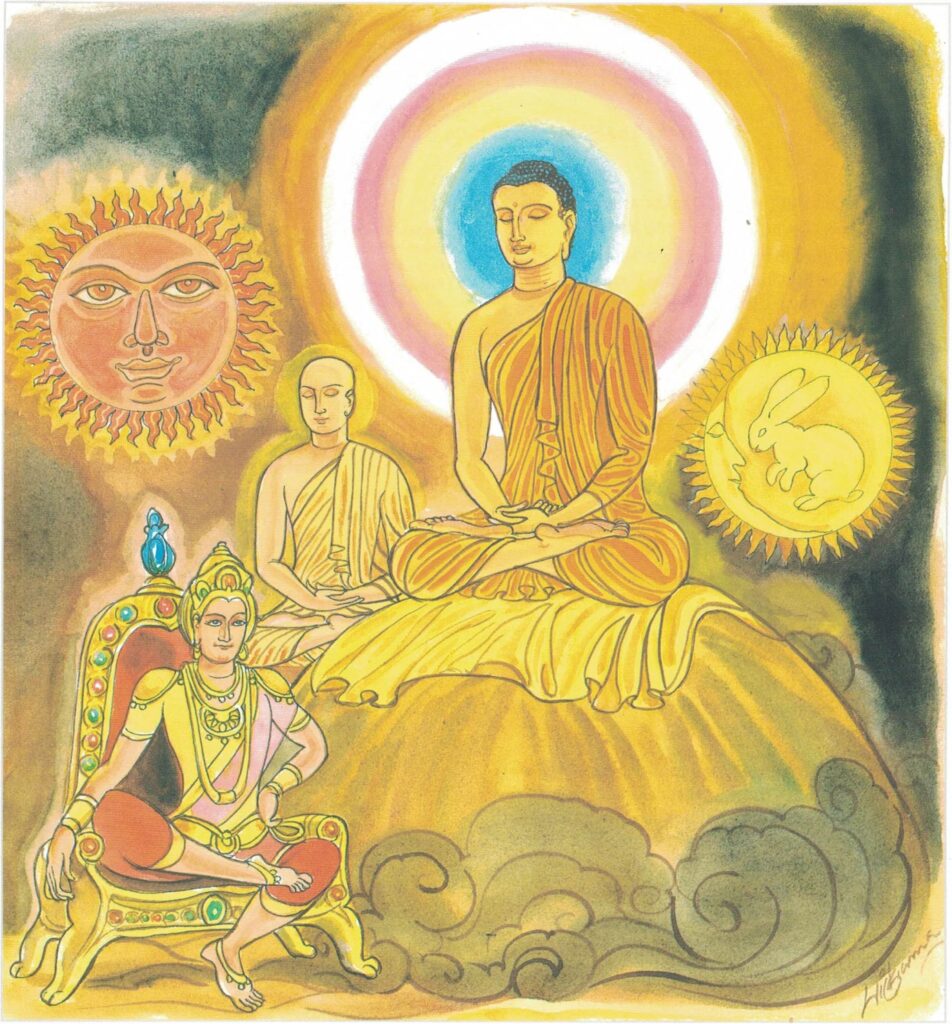Pali text, illustration and English translation of Dhammapada verse 387:
divā tapati ādicco rattiṃ ābhāti candimā |
sannaddho khattiyo tapati jhāyī tapati brāhmaṇo |
atha sabbam ahorattiṃ buddho tapati tejasā || 387 ||
387. The sun is bright by day, the moon enlights the night, armoured shines the warrior, contemplative the Brahmin True. But all the day and night-time too resplendent does the Buddha shine.

The Story of Venerable Ānanda
While residing at the Jetavana Monastery, the Buddha spoke this verse with reference to Venerable Ānanda.
The story goes that on the Great Terminal Festival, Pasenadi Kosala went to the monastery adorned with all the adornments, bearing perfumes, garlands and the like in his hands. At that moment Venerable Kāludāyi was sitting in the outer circle of the congregation, having entered into a state of trance. His body was pleasing to look upon, for it was of a golden hue. Now just at that moment the moon rose and the sun set. Venerable Ānanda looked at the radiance of the sun as the sun set, and of the moon as the moon rose; then he looked at the radiance of the body of the king and at the radiance of the body of the Venerable and at the radiance of the body of the Tathāgata. The Buddha far outshone the radiance of all the others.
The Venerable saluted the Buddha and said, “Venerable, as today I gazed upon the radiance of all these bodies, the radiance of your body alone satisfied me; for your body far outshone the radiance of all these other bodies.” Said the Buddha to the Venerable, “Ānanda, the sun shines by day, the moon by night, the king when he is adorned, the arahat when he has left human associations behind and is absorbed in trance. But the Buddhas shine both by night and by day, and shine with five-fold brightness.”
Explanatory Translation (Verse 387)
ādicco divā tapati candimā rattiṃ obhāti khattiyo
sannaddho tapati brāhmaṇo jhāyī tapati
atha sabbaṃ ahorattiṃ Buddho tejasā tapati
ādicco [ādicca]: the sun; divā: during day; tapati: shines; candimā: the moon; rattiṃ [ratti]: at night; obhāti: shines; khattiyo [khattiya]: the warrior; sannaddho [sannaddha]: dressed in his armour; tapati: gleams; brāhmano [brāhmana]: the brāhmaṇa; jhāyī: in meditation; tapati: shines; atha: but; sabbaṃ [sabba]: throughout; ahorattiṃ [ahoratti]: day and night; Buddho [Buddha]: the Buddha; tejasā: in his glory; tapati: shines
The sun shines during daytime. The moon beams at night. The warrior glows only when he has his armour on. The brāhmaṇa shines when he is concentrated on contemplation. All these people have various times to shine. But the Buddha glows all day and all night through his Enlightenment.
Commentary and exegetical material (Verse 387)
jhāyī: meditating; as one meditates; as an individual practises jhāna (concentration). The absorption in jhāna is a mental state beyond the reach of the five-fold sense-activity. This state can be achieved only in solitude and by unremitting perseverance in the practice of concentration.
Detached from sensual objects, detached from evil things, the disciple enters into the first absorption, which is accompanied by thought-conception and discursive thinking, is born of detachment, and filled with rapture and happiness.
This is the first of the absorptions belonging to the fine-material sphere (rūpāvacarajjhāna). It is attained when, through the strength of concentration, the five-fold sense-activity is temporarily suspended, and the five hindrances are likewise eliminated.
The first absorption is free from five things, and five things are present. When the disciple enters the first absorption, there have vanished the five hindrances: lust, ill-will, torpor and sloth, restlessness and mental worry, doubts; and there are present: thought-conception (vitakka), discursive-thinking (vicāra), rapture (pīti), happiness (sukha), and concentration (citt’ekaggatā–samādhi).
These five mental factors present in the first absorption are called factors (or constituents) of absorption (jhānaṅga). Vitakka (initial formation of an abstract thought) and vicāra (discursive thinking, rumination) are called verbal functions (vācā–sankhāra) of the mind; hence they are something secondary compared with consciousness. In visuddhi–magga, vitakka is compared with the taking hold of a pot, and vicāra with the wiping of it. In the first absorption both of them are present only in a weak degree, and are entirely absent in the following Absorptions.
And further, after the subsiding of thought-conception and discursive thinking, and by the gaining of inner tranquillity and oneness of mind, he enters into a state free from thought-conception and discursive thinking, the second absorption, which is born of concentration (samādhi) and filled with rapture (pīti) and happiness (sukha).
In the second absorption, there are three factors of absorption: happiness and concentration.
And further, after the fading away of rapture, he dwells in equanimity, mindful, with clear awareness; and he experiences in his own person that feeling of which the noble ones say: Happy lives he who is equanimous and mindful–thus he enters the third absorption.
In the third absorption there are two factors of absorption: equanimous happiness (upekkhā–sukha) and concentration (citt’ekaggatā).
And further, after the giving up of pleasure and pain, and through the disappearance of previous joy and grief, he enters into a state beyond pleasure and pain, into the fourth absorption, which is purified by equanimity and mindfulness.
In the fourth absorption there are two factors of absorption: concentration and equanimity (upekkhā).
In visuddhi–magga forty subjects of meditation (kammaṭṭhāna) are enumerated and treated in detail.